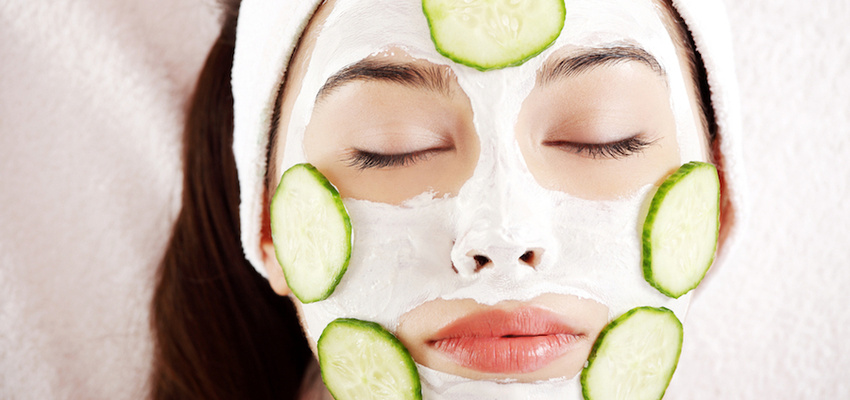5 All-Natural Tips To Get Rid Of Facial Redness
- Get link
- X
- Other Apps
5 All-Natural Tips To Get Rid Of Facial Redness
Whether your face flushes easily, is constantly red, or changes from day to day, facial redness can really make you crazy. In my holistic dermatology practice, it's one of the symptoms my patients find most upsetting by far. Acne sufferers may have background redness all over or, even worse, splotchy red patches. People with rosacea become easily red from triggers like the sun or a glass of wine. A condition called perioral dermatitis causes redness around the mouth, chin, nose and even up near the eyes.
Whatever the cause of your facial redness, here are some simple home treatments that are both gentle and effective.
1. Cucumber masks
Although there's been no scientific research validating cucumber's effect on facial redness, it has been documented as a natural home remedy for hundreds of years. Early records date back to 1649, when botanist and physician Nicholas Culpeper wrote of its benefits in clearing red from the face. Many people still swear by it. For best results, grate a cucumber or put it through a food processor to use as a face mask. For added cooling, use a cucumber straight from the fridge.
2. Anti-redness diet
The most important aspect of an anti-redness diet is to reduce systemic inflammation. Step one is to follow the general guidelines of an anti-inflammatory diet.
Also work to clear internal heat from the body. Avoid food and drinks that add "fuel to the fire," such as alcohol, spicy foods, and drinks that are hot in temperature.
Fish oil supplements and probiotics can be helpful. Cooling foods such as apple, celery, coconut, cucumber, melon, peach, papaya, and spinach should also be included.
3. Colloidal oatmeal masks
A popular remedy for itching and redness in eczema, colloidal oatmeal is a natural remedy that can benefit any kind of facial redness. Sometimes the best cures can be the simplest ones! Colloidal oatmeal is nothing more than pulverized oats. It has a moisturizing effect on the skin, but also absorbs oil and can be beneficial for acne.
In a 2007 Journal of Drugs in Dermatology article, colloidal oatmeal was shown to have moisturizing, soothing, protective and anti-inflammatory properties. It has a low potential for irritation and very low chance of allergies.
To use, pour a couple of teaspoons of 100% pure colloidal oatmeal into your hand and mix with enough water to make a mask. Let it dry for 10 minutes, then rinse off. This inexpensive treatment can be used up to four times per week.
4. Manuka honey
This special honey is produced primarily in New Zealand by bees that feed on the flowers of the manuka tree.
Rich in antioxidants, manuka is a powerful anti-inflammatory. It has antibacterial effects against the bacteria involved in acne. It additionally benefits rosacea and seborrheic dermatitis, eliminating redness while keeping the skin moisturized.
For topical use, purchase manuka that has a UMF/OMA rating of 15 or above. These rating numbers come from a system developed by scientists in New Zealand to describe the activity level of the honey. Apply directly to the skin as a daily cleanser.
5. Anti-redness teas
I recommend healing teas to many of my clients — both to drink and to use topically. Three of my favorites are peppermint, camomile and green tea.
The polyphenols in green tea have skin cell rejuvenating properties. Research abounds on the health benefits of drinking green tea. In addition, it’s a great topical wash, particularly for rosacea patients. Camomile and peppermint teas can benefit any type of facial redness. Don't use camomile if you have a ragweed allergy, though; the two plants are closely related.
To make a topical tea compress, steep several bags in a pot of boiling water for 10 minutes. Cool the liquid in the refrigerator. Pour onto a washcloth and press onto the face for up to a minute, one to two times per day.
As frustrating as it can be to battle facial redness, the good news is, it's usually quite easy to resolve. That said, many people I work with have highly sensitive skin that's easily irritated by any topical product (including botanical ones). If your skin fits this description, use caution when introducing new treatments. Stick to just one new treatment a week and do a spot test on a small area before using all over the face. And for sufferers of perioral dermatitis, I very often recommend doing nothing at all topically, simply treating internally with herbal remedies and dietary changes.
A true holistic approach to treating acne, rosacea and peroral dermatitis never relies on topical products alone. As the body's largest organ, the skin can reflect any number of internal imbalances. Healing from within is always the most effective road to a lasting cure.
Photo Credit: Shutterstock.com
- Get link
- X
- Other Apps

Comments
Post a Comment